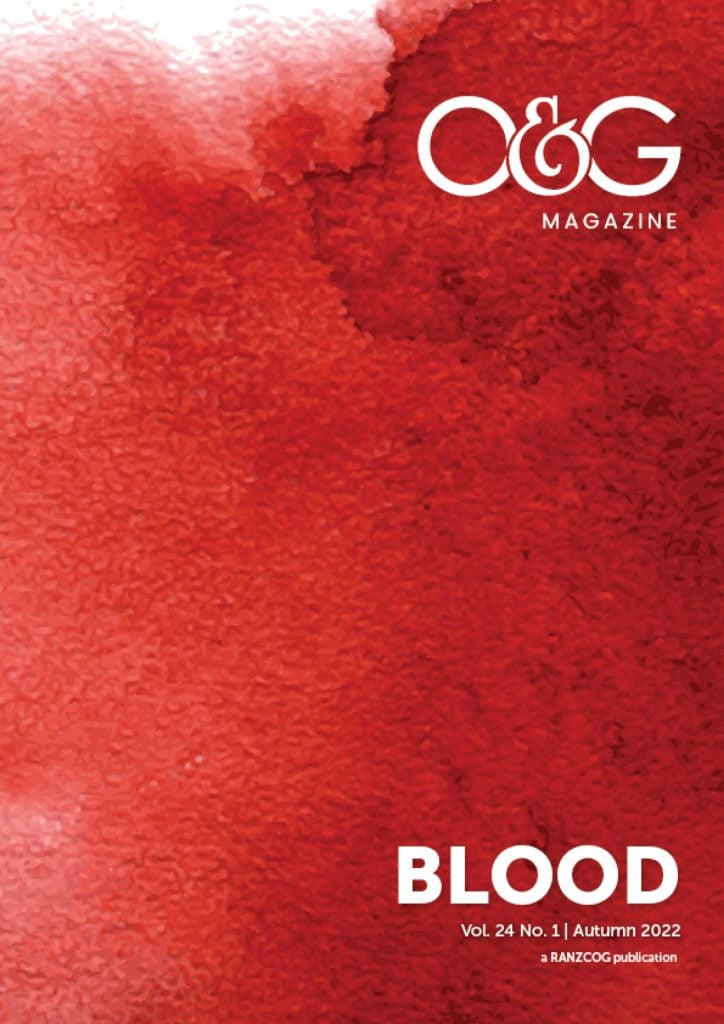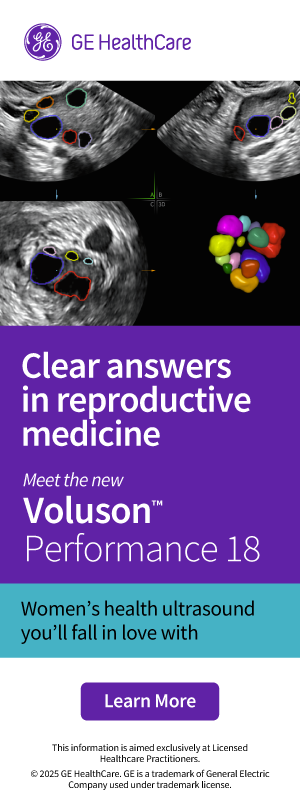Haemoglobinopathies encompass both the thalassaemia syndromes (alpha and beta thalassaemia) and structural haemoglobin variants. It is important to offer screening for pregnant women, ideally prior to conception, with the aim of detecting asymptomatic carriers so a couple may be counselled on reproductive risks and clinical implications to the fetus and child. Screening should include a full blood evaluation (FBE) and blood film, ferritin, and high-performance liquid chromatography (HPLC) or haemoglobin (Hb) electrophoresis.
Haemoglobin
The Hb molecule is a stable heterotetramer consisting of two pairs of globin polypeptide chains and a haem (iron component). The four globin chains determine the Hb type. Three main types of Hb are found in adults: Haemoglobin A (HbA), Fetal Haemoglobin (HbF) and Haemoglobin A2 (HbA2). HbA is made up of two alpha and two beta globin chains (α2/b2). HbF is made up of two alpha and two gamma globin chains (α2/g2). HbA2 is made up of two alpha and two delta globin chains (α2/d2).
Haemoglobinopathies
Genetic changes in the globin chains may result in altered production, structure, or function of Hb molecule. Over 1000 genetic variations have been described in the different globin chains.1
Thalassaemia is specific to alpha and beta globin chain production whereby it is reduced or ineffective. Mutations in alpha globin genes result in alpha thalassaemia and mutations in beta globin genes cause beta thalassaemia. Alpha and beta globin chains are normally produced in an exact ratio, and this is tightly regulated. When an individual has thalassaemia, this ratio is disrupted, leading to an imbalance of globin chains. This imbalance in globin chains contributes to the patient’s symptoms or clinical phenotype. Genetic mutations that result in an abnormal haemoglobin structure are called haemoglobin variants, including HbS, HbC, HbD, HbE, HbO and Hb Lepore. An individual may be both a carrier of thalassaemia and a carrier of a Hb variant.
Alpha thalassaemia
Alpha globin chain production is controlled by four genes (two genes on each chromosome 16). A deletion in one alpha globin gene results in a silent alpha carrier status (normal Hb with a normal or mildly reduced mean corpuscular volume [MCV]). A two gene alpha deletion usually results in a normal Hb with a reduced MCV and reduced mean corpuscular haemoglobin (MCH), termed alpha thalassaemia trait. Deletions in three alpha globin genes is termed Haemoglobin H (HbH) disease, due to the production of HbH (formed from four beta globin chains [b4]. HbH disease is associated with a moderately severe microcytic anaemia and haemolysis but varies in severity depending on the specific gene mutations. When all four alpha globin genes are deleted, resulting no alpha globin chain synthesis and production, Hb Barts (four gamma globin chains [g4]) is made. Bart’s hydrops fetalis is associated with non-immune hydrops and frequently fatal in utero and associated with significant maternal complications including hypertension, oedema, proteinuria, and mortality.2 A summary of the alpha globin gene mutations is provided in Table 1.
Table 1. Alpha globin gene mutations and expected clinical phenotype.
| Number of mutations | Genotype | Clinical Phenotype |
|---|---|---|
| 0 | αα/αα | Normal/Healthy |
| 1 | -α/αα | Silent Carrier/Healthy |
| 2 | -α/-α or –/αα | Carrier – reduced MCV and MCH |
| 3 | –/-α | HbH disease – Mild to severe haemolytic anaemia |
| 4 | –/– | Hb Barts – Hydrops fetalis |
Beta thalassaemia
There are two beta globin genes, one inherited from each parent. An individual with a mutation in one beta globin gene will typically have a mild microcytic hypochromic anaemia and is referred to as a carrier of beta thalassaemia (beta thalassaemia trait). Beta thalassaemia trait is associated with an elevated HbA2 due to reduced beta globin chains needed to make HbA and is usually diagnosed by HPLC. The degree of HbA reduction depends on the nature of the gene mutation, some cause reduced production of the beta globin chains whereas some result in no production.
If an individual has two beta globin gene mutations, they will have reduced or absent beta chain production, the severity of their disease will depend on the amount of normal beta chains produced and the specific genetic defects. Severely reduced beta globin gene production results in severe anaemia and requires regular blood transfusion and is termed beta thalassaemia major or transfusion-dependent beta thalassaemia.
Clinical manifestations of beta thalassaemia extend beyond anaemia to symptoms of increased and ineffective erythropoiesis such as bony expansion, hepatosplenomegaly and haemolysis. Ineffective erythropoiesis increases iron absorption which contributes to iron overload. Iron overload effects many organs including the heart, liver, kidneys, thyroid, pancreas, bone marrow and reproductive organs. Increased haemolysis increases gallstone production. Individuals with beta thalassaemia major also have a reduced life expectancy.3
Structural haemoglobin variants
There are a number of structural variants of clinical significance that may cause severe disease when inherited in the homozygous form (HbS/HbS – sickle cell disease) or in a compound heterozygote form with beta thalassaemia (eg. Hb E/beta thalassaemia). Many carriers of a Hb variant may have a normal FBE, including those who are heterozygous for HbS, HbC, HbE and HbD. These variants are often easily detected on Hb electrophoresis as they have different electrophoretic mobility compared with normal adult Hb.
Thalassaemia screening
Australia’s population is ethnically diverse and due to ongoing migration, thalassaemia carriers are increasing in our community.4 Carriers of thalassaemia or a structural variant may be asymptomatic and unaware of their risk in having an affected child. Prenatal screening allows health professionals to identify couples at risk of having a child with a major haemoglobinopathy. It is recommended that all pregnant women in Australia are offered testing, as selective testing based on ethnicity can be inaccurate.5 6
How does a Thalassaemia screen work?
Thalassaemia screening should be requested at the earliest possible timepoint, usually with the first trimester bloods, or prior to conception. This should include a FBE (to evaluate the Hb, MCV and MCH) and film, a ferritin to evaluate for iron deficiency and HPLC to quantify the percentages of HbA, HbA2 and HbF and detect for any Hb variants and/or Hb electrophoresis to help identify the structural variant.7 Thalassaemia screening will detect an individual who has iron deficiency, who is a carrier of beta thalassaemia trait (raised HbA2) or a structural Hb variant (eg. HbS) or raise suspicion that they are a carrier of alpha thalassaemia trait if they have a normal ferritin, normal HbA2 and still have microcytic, hypochromic red cell indices. Alpha thalassaemia gene testing requires DNA evaluation of the alpha globin genes and consent should be obtained for this genetic testing.
If maternal testing indicates normal red cell indices and normal HPLC (eg. does not have beta thalassaemia trait or a Hb variant), no further partner testing is required.
Iron is required for haemoglobin synthesis, and a FBE and blood film can be difficult to interpret in women with a low serum ferritin.8 A woman may need repeat thalassaemia screening when the iron stores are replete. It is important to treat any women found to have iron deficiency in pregnancy. In the instance of iron deficiency, the partner should undergo testing whilst she is being treated. If the partner has no evidence of being a carrier for thalassaemia or a haemoglobinopathy (normal MCV/MCH and normal HPLC) then no further investigation is required.
If both partners are suspected to be carriers of thalassaemia or a Hb variant, urgent genetic counselling and testing for both individuals are recommended. Genetic counselling or guidance should be consulted when there is a chance that a fetus may inherit a combination of mutations that results in severe clinical disease.
Prenatal diagnosis may be offered to couples at risk. It is important that even when prenatal diagnosis is not undertaken and a couple is at risk of an affected baby that appropriate evaluation occurs after delivery. For example, in the case of Sickle cell disease, so that an infant may be appropriately commenced on Penicillin.
Conclusion
Haemoglobinopathies are increasing in Australia. Making testing available to all women allows families to understand their risk of having a child affected by a haemoglobinopathy. It is often a two-stage process with an initial examination of the FBE, ferritin and Hb analysis of the mother, followed up by genetic and partner testing if a risk is identified. A third stage of testing, prenatal testing, may be offered if genetic testing of parents reveals a potential for a severe or life-threatening haemoglobinopathy to the fetus. We suggest that maternal thalassaemia screening occurs as early as possible so that couples are appropriately informed and counselled and so that prenatal testing can be offered.
Our feature articles represent the views of our authors and do not necessarily represent the views of the Royal Australian and New Zealand College of Obstetricians and Gynaecologists (RANZCOG), who publish O&G Magazine. While we make every effort to ensure that the information we share is accurate, we welcome any comments, suggestions or correction of errors in our comments section below, or by emailing the editor at [email protected].
References
- Hardison RC, Chui DH, Giardine B, et al. HbVar: A relational database of human hemoglobin variants and thalassaemia mutations at the globin gene server. Human Mutation. 2002;19:225.
- Songdej D, Babbs C, Higgs DR. An international registry of survivors with Hb Bart’s Hydrops Fetalis Syndrome. Blood. 2017:129(10):1251-9.
- Modell B, Khan M, Darlison M, et al. Improved survival of thalassaemia major in the UK and relation to T2 cardiovascular magnetic resonance. Journal of Cardiovascular Magnetic Resonance. 2008:10;42.
- Crighton G, Wood E, Scarborough R, et al. Haemoglobin disorders in Australia: where are we now and where will we be in the future? Internal Medicine Journal. 2016:46 (7);770-9.
- Dyson SM, Culley L, Gill C, et al. Ethnicity questions and antenatal screening for sickle cell/thalassaemia [EQUANS] in England: a randomised controlled trial of two questionnaires. Ethn Health. 2006;11(2):169–89.
- RANZCOG. Genetic Carrier Screening. March 2019. Available from: https://ranzcog.edu.au/statements-guidelines/obstetrics/genetic-carrier-screening-(c-obs-63)
- Metcalfe SA, Barlow-Stewart K, Campbell J, Emery J. Genetics and blood: Haemoglobinopathies and clotting disorders. Australian Family Physician. 2007;36(10):812-9.
- Bowden DK. Screening for thalassaemia. Australian Prescriber. 2001:24(5);120-3.






Leave a Reply